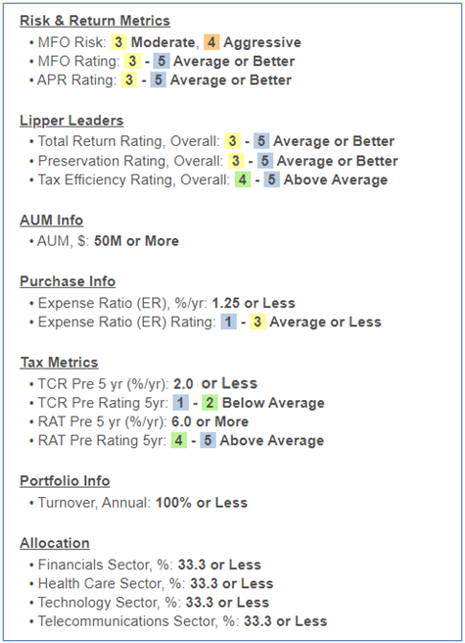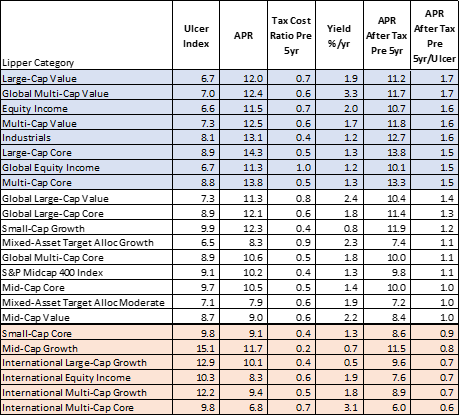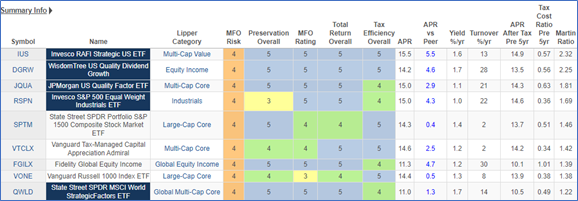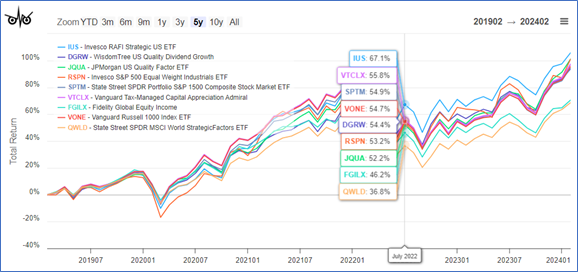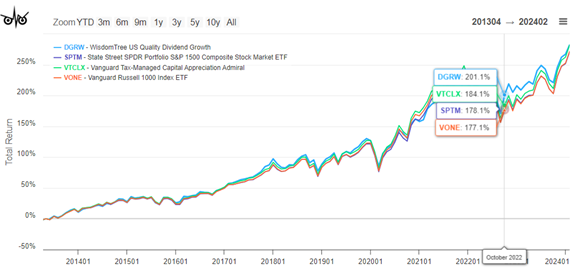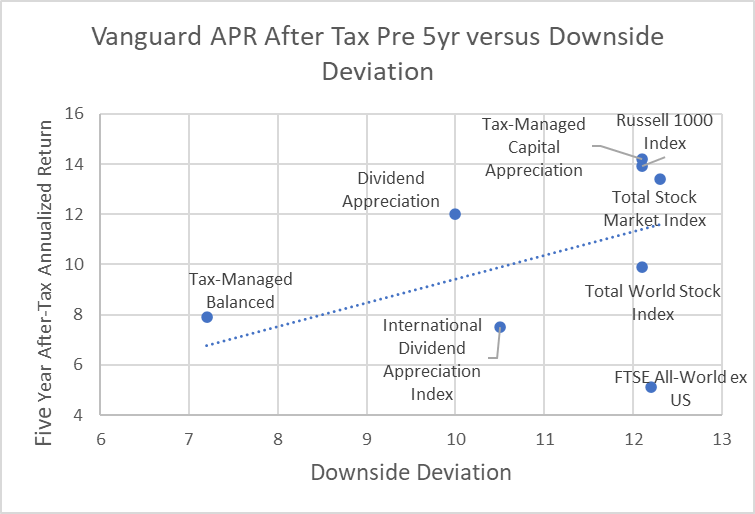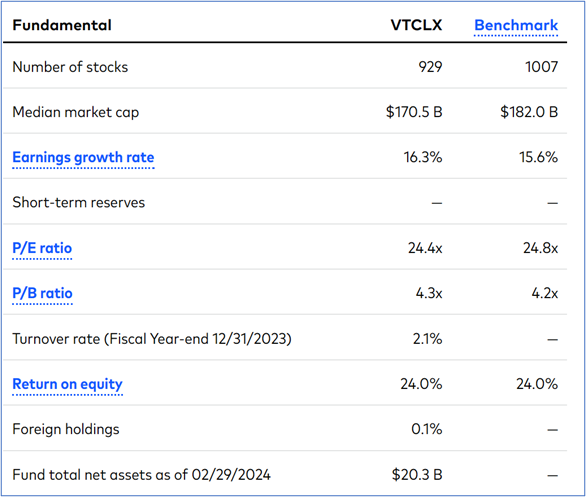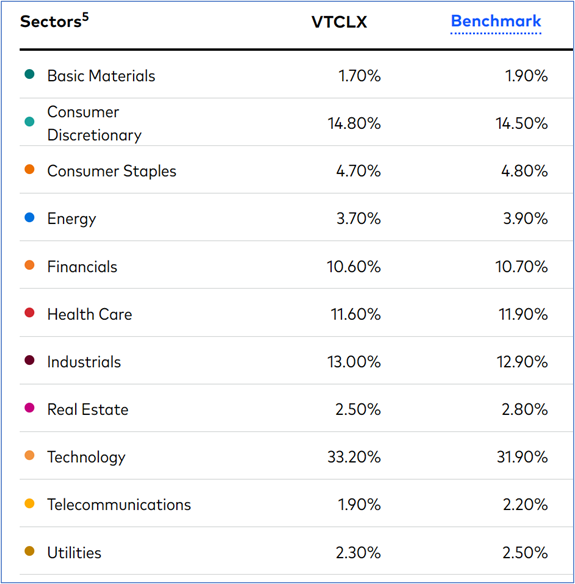It’s a great follow to take an intensive overview yearly of funding efficiency together with charges and taxes. A dual-income family might accumulate a half dozen or extra accounts due to tax traits, possession, and targets. A great way to begin is to checklist the accounts so as of deliberate withdrawals. The subsequent step is to make it possible for every account has the suitable quantity of threat and that the property inside are tax-efficient for the kind of account. I’m within the technique of changing Conventional IRAs to Roth IRAs and the conversion is taxed as extraordinary earnings. Municipal Bonds are included in Modified Adjusted Gross Earnings and will impression Medicare Premiums (IRMAA). In after-tax accounts, earnings is taxed whereas inventory appreciation will not be till offered after which typically at decrease capital positive factors charges. This is called the Bucket Strategy.
Our overview discovered that we had been paying over one p.c of property to have one particular goal, after-tax account managed with a 50% Inventory to 50% Municipal Bond Ratio. It’s a comparatively small, however vital account that I had arrange throughout unsure instances to be tax environment friendly. Within the hierarchy of withdrawals, it is going to be the final account tapped. The suitable objective for this account is for capital appreciation and ease whereas minimizing taxes. I take advantage of Constancy and Vanguard wealth administration providers for a few of our investments, and within the context of total portfolio administration, I’m on the lookout for a single tax-efficient fairness fund to “purchase and maintain” for this account.
This text is split into the next sections:
Funding Goal
Collectively, my investments resemble a 60% inventory/40% bond diversified portfolio, partly as a result of I’ve pensions and Social Safety to cowl most residing bills and may stand up to down markets. I focus Bucket #1 (Residing Bills) on short-term money equivalents similar to municipal cash markets and bonds. Bucket #2 is usually Conventional IRAs the place taxes are but to be paid and which have larger allocations to taxable bonds. Lengthy-Time period Bucket #3 consists of Roth IRAs and After-Tax Accounts that are concentrated in equities which might be tax-efficient if held for the long run or utilizing tax loss harvesting.
My targets for this one fund are 1) to have excessive after-tax returns, 2) to attenuate earnings and taxes, and three) to have respectable risk-adjusted returns as measured by the MFO Score. This sometimes means an fairness fund that pays low dividends and has low turnover.
Search Standards
Desk #1 exhibits the factors that I used for the preliminary search. I restricted the mutual funds to Constancy and Vanguard. Whereas volatility will not be a significant consideration for this fund, I wished to eradicate probably the most unstable funds.
Desk #1: Search Standards For Tax-Environment friendly Funds
Abstract Of Lipper Classes
After a technique of elimination, the search resulted in 32 mutual funds, and eighty-four exchange-traded funds in twenty-three Lipper Classes as proven in Desk #2. The classes are sorted from the very best five-year After-Tax Annualized Return/Ulcer Index. The Ulcer Index is a measure of the depth and period of drawdowns. The highest part shaded in blue incorporates the Lipper Classes that I’m most taken with, however I additionally wish to take into account international funds from the center part.
Desk #2: Tax-efficient Lipper Classes
Brief Record of Tax-Environment friendly Funds – 5-Yr View
I then went by way of the funds in every of the Lipper Classes and chosen one or two primarily based on after-tax return, fund household ranking, and tax effectivity, amongst different standards. The 9 funds in Desk #3 are excellent tax-efficient funds.
Desk #3: Brief Record of Tax-efficient Funds – 5 Years
Determine #1 exhibits the five-year efficiency of those funds. The 2 international funds have underperformed, however this doesn’t concern me due to stretched valuations within the US.
Determine #1: Efficiency of Brief Record of Tax-efficient Funds – 5 Years
Closing Record of Tax-Environment friendly Funds – Ten-Yr View
I then regarded on the funds over a ten-year interval. All the funds in Desk #4 are excellent, however I favor Vanguard Tax-Managed Capital Appreciation (VTCLX) and WisdomTree US High quality Dividend Progress (DGRW). Determine #2 exhibits the ten-year efficiency of those funds.
Desk #4: Closing Record of Tax-efficient Funds – Ten Years
Determine #2: Efficiency of Closing Record of Tax-efficient Funds – Ten Years
Vanguard Tax-Managed Capital Appreciation (VTCLX)
I made a decision to spend money on the Vanguard Tax-Managed Capital Appreciation Admiral Fund (VTCLX). The hyperlink to the documentation is right here. Determine #3 exhibits how VTCLX compares to different Vanguard funds for After-Tax Returns versus Draw back Deviation. It has excessive after-tax returns however roughly matches the full marketplace for volatility.
Determine #3: APR After-Tax Pre-5Year Versus Draw back Deviation
Product Abstract
“As a part of Vanguard’s collection of tax-managed investments, this fund provides traders publicity to the mid- and large-capitalization segments of the U.S. inventory market. Its distinctive index-oriented method makes an attempt to trace the benchmark whereas minimizing taxable positive factors and dividend earnings by buying index securities that pay decrease dividends. One of many fund’s dangers is its publicity to the mid-cap section of the inventory market, which tends to be extra unstable than the large-cap market. Traders in the next tax bracket who’ve an funding time horizon of 5 years or longer and a excessive tolerance for threat might want to take into account this fund complementary to a well-balanced portfolio.”
Fund Administration
Vanguard Tax-Managed Capital Appreciation Fund seeks a tax-efficient whole return consisting of long-term capital appreciation and nominal present earnings. The fund tracks the efficiency of the Russell 1000 Index—an unmanaged benchmark representing large- and mid-capitalization U.S. shares. The advisor makes use of portfolio optimization strategies to pick a pattern of shares that, within the mixture, replicate the traits of the benchmark index. The approach emphasizes shares with low dividend yields to attenuate taxable dividend distributions. As well as, a disciplined promote course of minimizes the belief of web capital positive factors and will embrace the belief of losses to offset unavoidable positive factors. The expertise and stability of Vanguard’s Fairness Index Group have permitted steady refinement of indexing strategies designed to attenuate monitoring error and supply tax-efficient returns.
Desk #5 incorporates the basics for VTCLX and Desk #6 incorporates the sector allocations.
Desk #5: VTCLX Fundamentals
Desk #6: VTCLX Sector Allocation
Closing
Over the subsequent ten years, changing this 50% Inventory/50% Bond account to DIY with one fairness fund ought to end in saving 1000’s of {dollars} in charges, enhance returns, and scale back taxes. It matches into an total balanced portfolio and meets my aims of retaining it easy. At the moment, this account has a combination of high quality ETFs. I’ll progressively convert them over to the Vanguard Tax-Managed Capital Appreciation (VTCLX) when market circumstances are favorable.


